In honor of President’s Day this month I will be writing several Travel posts about several historical landmarks located in Washington, D.C. – the Lincoln Memorial, the Washington Monument and the White House. Two of the memorials are dedicated to former United States Presidents and the third has been the home of every United States President since John Adams.
The Lincoln Memorial is a national monument built to honor President Abraham Lincoln, the 16th President of the United States, and it is located in Washington, D.C. at the west end of the National Mall. Shortly after Lincoln’s assassination in 1865 plans started for a permanent national memorial. In 1867, Congress passed a bill to create a commission to erect a monument and preliminary plans were drawn but the project was not able to raise the funds required to build and several years passed with nothing accomplished.
From 1901 to 1908, five additional bills were proposed in Congress but failed to pass. Then, in late 1910, a sixth attempt was successful and a bill passed. The next year, a new Lincoln Memorial Commission was formed and by 1913 Congress approved the Commission’s recommendations for a location and a memorial design. The site selected was located overlooking the Potomac River in an area known as West Potomac Park. The architect chosen for the building was Henry Bacon and the sculptor selected for creating the statue of Lincoln was Daniel Chester French and the painter chosen for the interior murals was Jules Guerin. On February 12, 1914 ground was officially broken to start construction, the date was significant because it marks the annual celebration of Lincoln’s birthday. When the building was completed eight years later, there was a memorial dedication on May 30, 1922 and in attendance on that day was Lincoln’s only surviving son, 79 year old Robert Todd Lincoln.
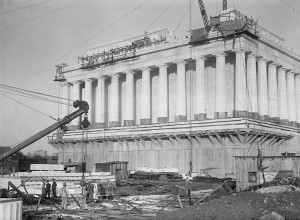
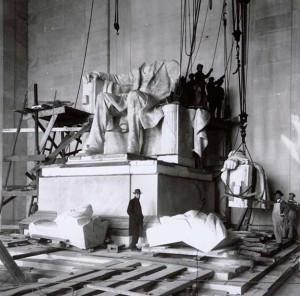
The building is designed in the form of a classic Greek temple, the building measures 190 feet by 119 feet and is 99 feet tall. Special attention was given to certain symbolic details of the building, such as the 36 fluted Doric columns which represent the 36 states in the Union at the time of Lincoln’s death. Each column stands 44 feet tall and measures 7.5 feet in diameter which are slightly angled toward the building. Inscribed on the frieze located on the upper portion of the building are the names of the 36 states and the dates that each entered the Union, in between each state name are a bas-relief double wreath medallion. Then on the cornice above at the 48 states in the Union at the time of the memorial’s dedication with a carved scroll alternating with lion heads. At the top is a garland, ribbons, palm leaves and eagles. The entire building is set on a concrete foundation which measures 44 to 66 feet in depth and then enclosed with a 187 feet by 257 feet rectangular granite retaining wall which measures 14 feet high. The Lincoln Memorial is entered on the east side of the building with steps beginning at the edge of the Reflecting Pool. Other Washington D.C. landmarks are within easy walking distance, such as the Washington Monument, the Jefferson Memorial, the Vietnam Veterans Memorial and National World War II Memorial.
The interior of the building is divided into three sections by two rows of Ionic columns, four in each row and they measure 50 feet tall and 5.5 feet in diameter. The North section has an inscription of Lincoln’s second inaugural speech and the south section has the complete Gettysburg Address. Above each of the inscriptions is a 60 foot by 12 foot murals which depict principles important in Lincoln’s life, the north wall has Unity, Fraternity and Charity and the south wall has Freedom, Liberty, Immortality, Justice and Law.
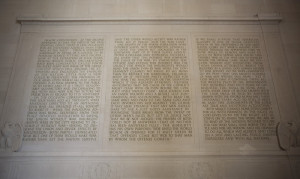
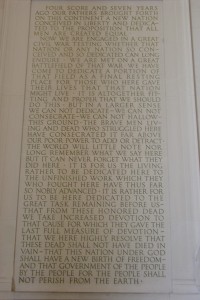
The ceiling of the memorial was designed to allow light into the interior and this was beautifully achieved with a pattern of bronze beams decorated with laurel and oak leaves, panels of thin marble treated with paraffin wax was used to create a translucency. Additional artificial lighting was required to light the large Lincoln statue properly and this was achieved in 1929 when specially designed louvered lighting was added. The memorial has remained unchanged until the mid-1970s when an elevator was added to accommodate handicapped visitors.
The main feature of the memorial is the large statue of the seated figure of President Abraham Lincoln which is placed in the center section. Under the supervision of the sculptor, Daniel Chester French, the statue was carved from Georgia white marble by the Puccirilli Brothers and it took four years to complete. The statue is 19 feet tall measuring from head to foot, 19 feet wide and weighs 175 tons. The statue sits on a pedestal of Tennessee marble which stands 10 feet high, 16 feet wide and 17 feet in depth which sits on another platform of Tennessee marble that is 34.5 feet long, 28 feet wide and 6.5 inches high. On the wall behind the statue there is an engraving which reads, “In this temple as in the hearts of the people for whom he saved the Union the memory of Abraham Lincoln is enshrined forever”.
The Lincoln Memorial is seen by approximately 3 million visitors every year, it is always open to the public and free of charge, the Memorial is currently under the administration of the National Parks Service. On October 15, 1966 the Memorial was officially listed on the National Register of Historic Places.
Lincoln Memorial Trivia
- If one looks closely, there are many symbolic features of the memorial, such as the 36 columns represent the 36 states of the United States at the time of Lincoln’s death in 1865.
- When the monument was completed in May 1922, the United States had increased in size to include 12 more states, to reflect this the names of all 48 states were carved on the upper portion of the wall on the outside of the monument. After the admission of Alaska and Hawaii to the United States, a plaque was added to the monument with the names of the two new states.
- The memorial has 58 steps, 56 steps represent Lincoln’s age at the time of his assassination and the remaining 2 steps represent the number of terms that Lincoln served as the President of the United States.
- There have been many interpretations as to the different features of the Lincoln statue displayed in the Lincoln Memorial and one those is the position of Lincoln’s hands. The statue’s sculptor, Daniel Chester French had a deaf son so he was familiar with the American Sign Language, so it has been speculated that he carved the left hand to form an “A” and the right hand to form an “L” thus representing the president’s initials. Unfortunately, there is no documented proof that this was French’s original intention.
- An image of the Lincoln Memorial can be seen on both the US penny and the US five dollar bill.
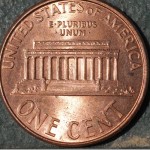
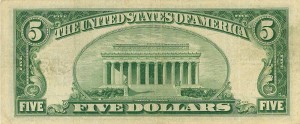
August 28, 1963 – Martin Luther King JR. made his famous civil rights speech, “I Have a Dream” on the steps of the Lincoln Memorial. In 2003, on the 40th anniversary of the event, an engraved plaque was placed on the eighteenth step located below the Lincoln statue and on the exact spot where King delivered his speech.
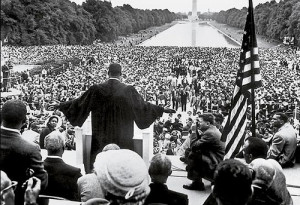
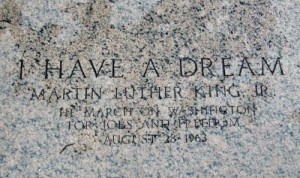
April 9, 1939 – Previously the DAR (Daughters of the American Revolution) had refused permission for Marian Anderson (an African-American classical singer) to sing at Constitution Hall because at the time Washington D.C. was a segregated city. As a result, thousands of DAR members were outraged by the injustice and resigned their memberships in protest. One of those members was the First Lady Eleanor Roosevelt and she went on to arrange for Marian Anderson to perform the concert on the steps of the Lincoln Memorial. The event was attended by an audience of more than 75,000 people of all races and also broadcast to a radio audience of millions.
January 18, 2009 – Two days before President Barack Obama inauguration as the 44th President of the United States a concert was held on the steps of the memorial, it was officially called the “We Are One: The Obama Inaugural Celebration at the Lincoln Memorial”. An estimated crowd of over 400,000 people converge on the area surrounding the National Mall in Washington D.C. The concert featured performances by musical acts such as Jon Bon Jovi, Garth Brooks, Bruce Springsteen, U2 and Stevie Wonder.
For additional Abraham Lincoln sites and landmarks in other parts of the United States, please click on the link to New Salem, IL for information about where Lincoln lived during his early adult years and Springfield, IL Part One for information about the Lincoln Presidential Library and Springfield, IL Part Two for information about Lincoln’s Home, Law Offices and the Lincoln Tomb which is his final resting place.


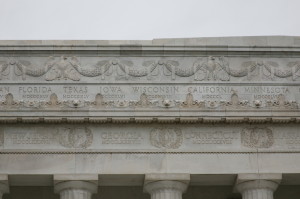
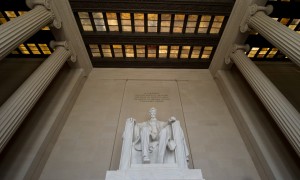
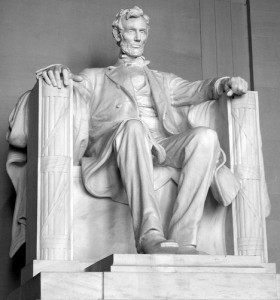
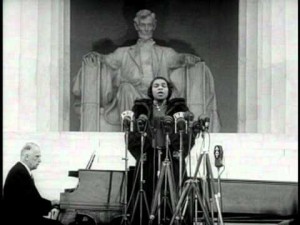
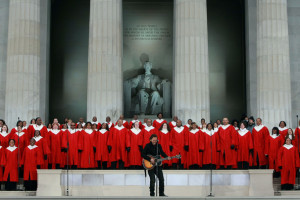
Pingback: Travel – The White House (Part Three) | The Enchanted Manor
Pingback: Travel – The White House (Part One) | The Enchanted Manor
I enjoyed this post very much. Living in DC takes me by the Lincoln Memorial often, but this post makes me want to stop and spend some time there. Thanks.
Pingback: Travel – Springfield, Illinois (Part Two) | The Enchanted Manor